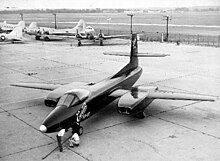| XF-87 Blackhawk | |
|---|---|
 | |
| General information | |
| Type | Interceptor aircraft |
| National origin | United States |
| Manufacturer | Curtiss-Wright |
| Status | Canceled 10 October 1948 |
| Primary user | U.S. Air Force |
| Number built | 2 |
| History | |
| First flight | 5 March 1948 |
The Curtiss-Wright XF-87 Blackhawk (previously designated the XP-87) was a prototype American all-weather jet fighter-interceptor, and the company's last aircraft project. Designed as a replacement for the World War II–era propeller-driven P-61 Black Widow night/interceptor aircraft, the XF-87 lost in government procurement competition to the Northrop F-89 Scorpion. The loss of the contract was fatal to the company; the Curtiss-Wright Corporation closed down its aviation division, selling its assets to North American Aviation.
Design and development
The aircraft started life as a project for an attack aircraft, designated XA-43. When the United States Army Air Forces issued a requirement for a jet-powered all-weather fighter in 1945, the design was reworked for that request.
The XP-87 was a large mid-wing aircraft with four engines paired in underwing pods, with a mid-mounted tailplane and tricycle undercarriage. Two crew members (pilot and radar operator) sat side by side under a single canopy. Armament was to be a nose-mounted, powered turret containing four 20 mm (0.79 in) cannon, but this was never fitted to the prototypes. Instead the aircraft was armed with four fixed forward firing 20mm cannon.
Operational history
The first flight of the XF-87 Blackhawk was on 5 March 1948. Although the top speed was slower than expected, the aircraft was otherwise acceptable, and the newly formed (in September 1947) United States Air Force placed orders for 57 F-87A fighters and 30 RF-87A reconnaissance aircraft just over a month later. Since the performance problems were due to lack of power, the four Westinghouse XJ34-WE-7 turbojets of the prototypes were to be substituted for two General Electric J47 jets in production models. One of the two XF-87 prototypes was to be modified as a test bed for the new engines.
At this point, the USAF decided that the Northrop F-89 Scorpion was a more promising aircraft. The F-87 contract was canceled on 10 October 1948, and both prototypes were scrapped.
Variants


- XP-87
- First flight was March 5, 1948
- XF-87
- Redesignated XP-87
- F-87A
- Production fighter version (canceled)
- RF-87A
- Reconnaissance variant (canceled)
Specifications (XF-87 No.1)
Data from Curtiss Aircraft 1907–1947
General characteristics
- Crew: 2
- Length: 62 ft 10 in (19.15 m)
- Wingspan: 60 ft 0 in (18.29 m)
- Height: 20 ft 0 in (6.10 m)
- Wing area: 600 sq ft (56 m)
- Empty weight: 25,930 lb (11,762 kg)
- Gross weight: 49,900 lb (22,634 kg)
- Powerplant: 4 × Westinghouse XJ34-WE-7 turbojet engines, 3,000 lbf (13 kN) thrust each
Performance
- Maximum speed: 600 mph (970 km/h, 520 kn) at sea level
- Range: 1,000 mi (1,600 km, 870 nmi)
- Service ceiling: 41,000 ft (12,000 m)
- Time to altitude: 35,000 ft (11,000 m) in 13 minutes 48 seconds
Armament
- Guns: 4 × 20 mm (0.787 in) AN/M2 cannon in the nose
See also
Aircraft of comparable role, configuration, and era
Related lists
References
Notes
- Winchester 2005, pp. 72–73.
- Bowers, Curtiss Aircraft, pp.509-510
- Associated Press, "Four-Jet Fighter, Weighing as Much As B-17, Tested", San Bernardino Daily Sun, San Bernardino, California, Tuesday 2 March 1948, Volume LIV, Number 158, page 1.
- Bowers, Peter M. (1979). Curtiss aircraft, 1907-1947. London: Putnam. pp. 508–510. ISBN 0370100298.
Bibliography
- Angelucci, Enzo and Peter Bowers. The American Fighter: The Definitive Guide To American Fighter Aircraft From 1917 To The Present. New York: Orion Books, 1987. ISBN 0-517-56588-9.
- Bowers, Peter M. Curtiss Aircraft 1907–1947. London: Putnam, 1979. ISBN 0-370-10029-8.
- Buttler, Tony. American Secret Projects: Fighters & Interceptors 1945–1978. Hinckley, UK: Midland Publishing, 2008, First edition, 2007. ISBN 978-1-85780-264-1.
- Jenkins, Dennis R. and Tony R. Landis. Experimental & Prototype U.S. Air Force Jet Fighters. North Branch, Minnesota, USA: Specialty Press, 2008. ISBN 978-1-58007-111-6.
- Green, William and Gordon Swanborough. The Great Book Of Fighters: An encyclopedia of every fighter aircraft built and flown. Osceola, WI, USA: MBI Publishing Company, 2001. ISBN 0-7603-1194-3.
- Knaack, Marcelle Size. Encyclopedia of US Air Force Aircraft and Missile Systems: Volume 1 Post-World War II Fighters 1945–1973. Washington, DC: Office of Air Force History, 1978. ISBN 0-912799-59-5.
- Pace, Steve. X-Fighters: USAF Experimental and Prototype Fighters, XP-59 to YF-23. St. Paul, Minnesota, USA: Motorbooks International, 1991. ISBN 0-87938-540-5.
- Winchester, Jim. Concept Aircraft: Prototypes, X-Planes and Experimental Aircraft. Rochester, Kent, UK: Grange books plc, 2005. ISBN 1-84013-809-2.
External links
- Curtiss XP-87/XF-87 Blackhawk
- Uncommon Aircraft: XF-87 Blackhawk
- Several pictures of the XF-87 45-59600
| Curtiss and Curtiss-Wright aircraft | |||||||||||||||||||||||||||||||||||||||||||||||||||||||||
|---|---|---|---|---|---|---|---|---|---|---|---|---|---|---|---|---|---|---|---|---|---|---|---|---|---|---|---|---|---|---|---|---|---|---|---|---|---|---|---|---|---|---|---|---|---|---|---|---|---|---|---|---|---|---|---|---|---|
| Manufacturer designations |
| ||||||||||||||||||||||||||||||||||||||||||||||||||||||||
| Operator and role |
| ||||||||||||||||||||||||||||||||||||||||||||||||||||||||
| Designation skipped Not built | |||||||||||||||||||||||||||||||||||||||||||||||||||||||||
| USAAS/USAAC/USAAF/USAF fighter designations 1924–1962, and Tri-Service post-1962 systems | |||||||||||
|---|---|---|---|---|---|---|---|---|---|---|---|
| 1924 sequences (1924–1962) |
| ||||||||||
| Tri-service sequence (1962–present) |
| ||||||||||
| Covert designations | |||||||||||
| Related designations | |||||||||||
| Not assigned • Unofficial • Assigned to multiple types See also: "F-19" • 1919–1924 sequence | |||||||||||
| United States attack aircraft designations, Army/Air Force and Tri-Service systems | |||||
|---|---|---|---|---|---|
| Army/Air Force sequence (1925–1962) | |||||
| Tri-Service sequence (1962–present) |
| ||||
| Related designations | |||||
| Not assigned • Unofficial designation • Assigned to multiple types Not to be confused with the aerial target or amphibious aircraft sequences. | |||||